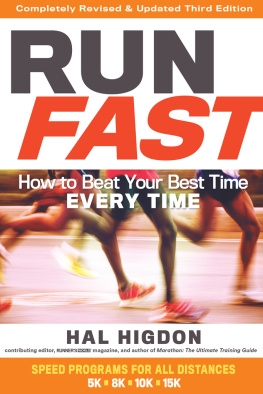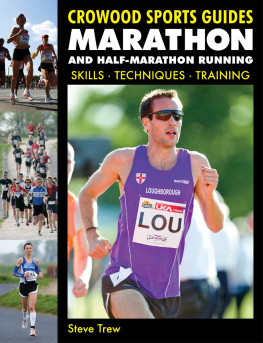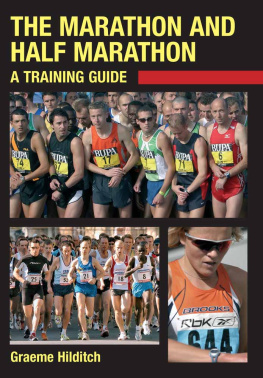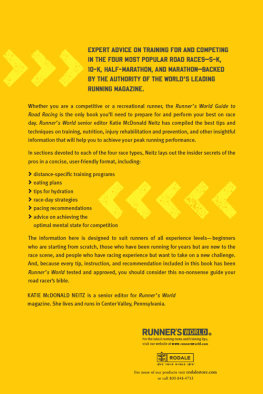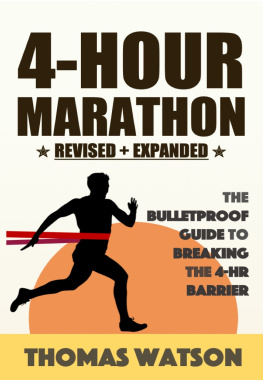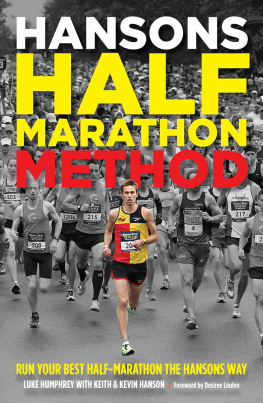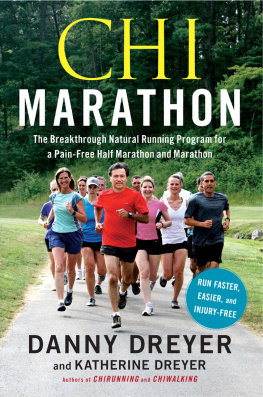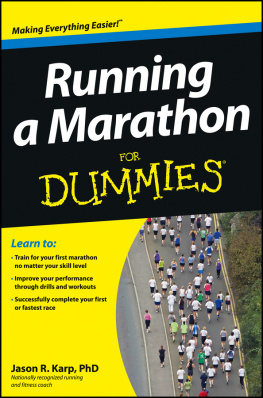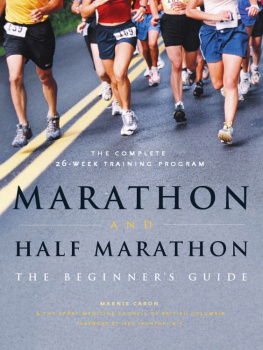
Library of Congress Cataloging-in-Publication Data
Names: Higdon, Hal.
Title: Hal Higdon's half marathon training / Hal Higdon.
Description: Champaign, IL : Human Kinetics, [2016] | Includes
bibliographical references.
Identifiers: LCCN 2015037239 | ISBN 9781492517245 (print)
Subjects: LCSH: Marathon running--Training. | Long distance runners--Training
of.
Classification: LCC GV1065.17.T73 H54 2016 | DDC 796.42/52--dc23 LC record available at http://lccn.loc.gov/2015037239
ISBN: 978-1-4925-1724-5 (print)
Copyright 2016 by Hal Higdon
All rights reserved. Except for use in a review, the reproduction or utilization of this work in any form or by any electronic, mechanical, or other means, now known or hereafter invented, including xerography, photocopying, and recording, and in any information storage and retrieval system, is forbidden without the written permission of the publisher.
This publication is written and published to provide accurate and authoritative information relevant to the subject matter presented. It is published and sold with the understanding that the author and publisher are not engaged in rendering legal, medical, or other professional services by reason of their authorship or publication of this work. If medical or other expert assistance is required, the services of a competent professional person should be sought.
The web addresses cited in this text were current as of November 2015, unless otherwise noted.
Senior Managing Editor: Elizabeth Evans
Copyeditor: Annette Pierce
Permissions Manager: Martha Gullo
Senior Graphic Designers: Nancy Rasmus and Fred Starbird
Graphic Designer: Denise Lowry
Cover Designer: Keith Blomberg
Photograph (cover): iStock.com/lzf
Photographs (interior): Human Kinetics, unless otherwise noted
Photo Asset Manager: Laura Fitch
Photo Production Manager: Jason Allen
Printer: United Graphics
Human Kinetics books are available at special discounts for bulk purchase. Special editions or book excerpts can also be created to specification. For details, contact the Special Sales Manager at Human Kinetics.
Printed in the United States of America
10 9 8 7 6 5 4 3 2 1
The paper in this book is certified under a sustainable forestry program.
Human Kinetics
Website: www.HumanKinetics.com
United States: Human Kinetics
P.O. Box 5076
Champaign, IL 61825-5076
800-747-4457
e-mail: info@hkusa.com
Canada: Human Kinetics
475 Devonshire Road Unit 100
Windsor, ON N8Y 2L5
800-465-7301 (in Canada only)
e-mail: info@hkcanada.com
Europe: Human Kinetics
107 Bradford Road
Stanningley
Leeds LS28 6AT, United Kingdom
+44 (0) 113 255 5665
e-mail: hk@hkeurope.com
Australia: Human Kinetics
57A Price Avenue
Lower Mitcham, South Australia 5062
08 8372 0999
e-mail: info@hkaustralia.com
New Zealand: Human Kinetics
P.O. Box 80
Mitcham Shopping Centre, South Australia 5062
0800 222 062
e-mail: info@hknewzealand.com
E6660
For the friends who follow me on Facebook. I learn as much from them as they from me.
Contents
Introduction
Downsizing, clearing out the clutter in our basement, I recently came across a box of plaques: awards accumulated during a long career of running, too many to hang on a wall, so despite all the effort and energy spent winning those plaques, for a long time they had been set aside, stuffed on a shelf, not seen for years. But now what to do with them? Should my wife, Rose, and I force younger family members to accept plaques as fond memories of a grandparent? Should we offer them on eBay to strangers not met, who nevertheless might appreciate them more than we? Or would the plaques be best deposited in a dumpster, to be uncovered centuries later by archeologists curious about an ancient civilization? A civilization that featured running as one of its main recreational activities.
But one plaque at the top of the pile stood out, spoke to me. Made of maple with a golden panel attached, it served as proof that on September 11, 1977, I had won the masters division of the Cleveland Heart-A-Thon.
Heart-a-thon? What exactly was a heart-a-thon? The word fails to attract an entry in the massive Random House Dictionary of the English Language that dominates a book shelf in my office. Even the Internet fails to provide a precise definition. Fortunately, the plaque identified the distance of the race I had runand wonso long, long ago: 13.1 miles!
Thus, a heart-a-thon (at least that one in Cleveland that bygone year) was 13.1 miles, a race distance now more properly identified as a half marathon, half the 26.2 miles of the full marathon that attracts so many to the running sport. And while I do not have a plaque to prove my participation, because I did not run the race, another 13.1-miler emerged that same year (1977) in Indianapolis, its true distance similarly disguised under the label minimarathon. Currently, according to Running USA, the main source of facts and statistics for road racing in the United States, the OneAmerica 500 Festival Mini-Marathon (or Indy Mini) is one of the largest half marathons in the United States with approximately 22,500 finishers in the half in 2015 and another 3,500 finishers in the accompanying 5K. (Gothenburg, Sweden, hosted the worlds largest half, with 47,403 finishers that same year.)
As for the oldest half marathon, at least in the United States, the Caesar Rodney Half Marathon in Wilmington, Delaware, founded in 1964, might have a claim on that title. Despite its historical claim to fame, Caesar Rodney remains a relatively small event today: 1,245 runners and walkers in a combined 5K and half marathon in 2015.
Heart-A-Thon. Minimarathon. What else? The Philadelphia Distance Run, also founded in 1977, is another 13.1-mile race that still fails to advertise its distance. It was almost as though in the 1970s (the decade when running emerged as a popular participant sport), new runners were embarrassed to admit to running only a 13.1-mile race when they could bemaybe should berunning a 26.2-mile race, a full-distance marathon, a more heroic event.
How life changes. No more! Because today certainly no embarrassment exists among people running a half marathon vs. a full marathon. In 2014, according to Running USA, 2,200 half marathons were held in the United States. Nearly four times as many runners participated in half marathons than in full marathons: 2,046,600 vs. 550,637 finishers. On the list of the 100 largest American races, 40 were half marathons. As for trends, the number of half marathon finishers in the United States quadrupled between the years 2000 and 2014.
Why such interest in the half marathon? The obvious reason would seem to be that it is an easier distance for beginning runners to achieve. Less scary. Easier to climb Pikes Peak than Mount Kilimanjaro or Mount Everest. You dont have to train as many weeks or miles. Training for a half marathon thus fits more conveniently into a busy lifestyle than training for a full marathon. My half marathon training programs (provided later in this book) last 12 weeks compared to 18 weeks for full marathons. The weekly mileage for my half programs is somewhat less. The daily mileage also is somewhat less. For example, the maximum long run for runners using my novice 1 half marathon training program is 10 miles (16 km) instead of 20 miles (32 km) for full marathons. An easier path to glory would seem to be one reason for the halfs popularity, except Im not sure that remains entirely true, or at least it is not the only reason.
Next page

